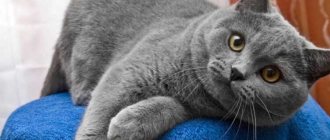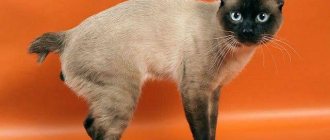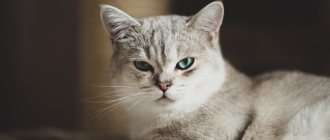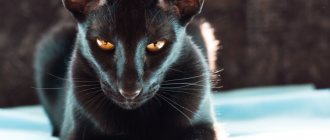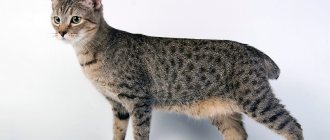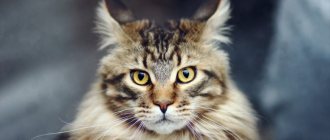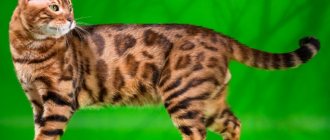Origin story
The history of this breed goes back hundreds of years, and scientists still cannot say exactly where in the world these cats appeared. There is only an assumption that many centuries ago, clever mousecatchers arrived in Japan from China. However, initially their tails were the length familiar to those around them, and only much later, as a result of mixing of blood, did it shorten several times.
The superstitious Japanese only liked this change: they began not only to have bobtails in their homes, but also to depict them on canvas and sing them in poetry, and over time, these cats earned the highest imperial favor and ended up in the palace.
Bobtails were exported outside Japan only in 1967, when one of the breeders named Elizabeth Freret managed to buy and export three individuals to the American continent. A little later, several more animals were literally obtained through smuggling.
The standard was established in 1968, the same year the breed was registered with the CFA. But this only concerned individuals with short fur. Cats with a long “fur coat” were discarded for many years, until someone particularly meticulous, delving into ancient sources, found out that long-haired individuals were also kept at the emperor’s court and were valued no less than their counterparts. In 1990, they were also recognized.
Thinking about buying a Japanese Bobtail? You have a direct route to the nursery. Fortunately, it is in Russia: in the Moscow region, in the city of Zavidovo. On the territory of Belarus and Ukraine, alas, there are no nurseries or private breeders. The cost of an individual for a house from which there will be no offspring is approximately 30-40,000 rubles. Animals of a higher class will cost 2, 3 and even 4 times more expensive. But in Russia it is almost impossible to buy a show-class bobtail.
Tips for buying a Japanese Bobtail kitten
You should not buy a Japanese Bobtail from your hands or through message boards. The breed is rare in our country, and owners of purebred kittens distribute them through nurseries.
The largest in Russia are Bunny-Boom in Yekaterinburg, Innosima in Ryazan, and Samurai in Kodinsk. In Europe, the best nursery for Japanese bobtails is ELLESMERA in Tallinn.
General tips when choosing a Japanese Bobtail:
- Don’t be surprised by the unusually large dimensions of the kittens. Japanese Bobtails grow and gain weight faster than most of their relatives.
- When examining a kitten, pay special attention to the configuration of the tail. It is its deviations from the standard that are the basis for rejection (that is, it will then be impossible to obtain a certificate or participate in exhibitions or breeding of the breed). A tail that extends far from the body (more than 1/5 of the length of the body) or a complete absence of caudal vertebrae (taillessness) is considered a defect.
- Buy only cubs with a veterinary passport and a Japanese Bobtail kitten certificate. Be sure to check the pedigree of his parents. If the seller refuses to show any of these documents, then the transaction is not worth it.
The price of Japanese Bobtail kittens traditionally depends on the class of the animal (breed, show, pet - with a full set of breed characteristics, with minor deviations or with disqualifying defects). The cost is also influenced by the championship titles of the parents. The average price for a club kitten from a certified couple is 40,000–60,000 rubles. A baby with a modest pedigree or the presence of defects costs from 20,000 rubles.
Japanese Bobtail kittens are large and look older than their peers of other breeds
Standards
| Standard | Description |
| Scull | Triangular, with clearly defined cheekbones and plump whisker pads on a funny oriental muzzle. |
| Nose | Medium length, with a pronounced “stop” on the bridge of the nose. |
| Eyes | Large, oval, wide open, set slightly askew. The color of the iris can be any. |
| Ears | Large and erect, densely pubescent on the inside. Small tassels may grow on the tips. |
| Torso | The body is long and rectangular. The muscles are visible, the general impression is that the cat is “lean”, gracefully built. The limbs are slender, long (the forelimbs are noticeably shorter than the hind limbs), arranged in the shape of the letter Z. The paws are oval and elastic. |
| Tail | Set high and curled into a ball. Its length in the straightened state is no more than 8 cm. The tails are conventionally divided into spiral and chrysanthemum-shaped. |
| Wool | The coat is thick and neat. Both short-haired and long-haired cats have very soft hair with no undercoat. In the area of the hind legs it grows thicker and more abundantly, forming lush pantaloons. |
Disqualifying signs:
- Strongly built body.
- Oval or round skull shape.
- A long tail.
- Small ears.
- Button nose.
Interesting facts about the breed
- According to one legend, Japanese cats initially had normal long fluffy tails, until a cat named Nenomata appeared, whose tail harbored an evil force that brought disease and death to the samurai. To protect themselves from evil spirits, the Japanese left only short-tailed cats alive. Bobtails have become sacred animals.
- An image of a short-tailed cat with its paw raised in greeting was discovered in the Japanese Gotokuju Temple. In a modern Japanese home you can see an image of such a cat as a symbol of well-being.
- According to experts and breeders, modern Japanese bobtails are developed at the level of a 3-year-old child and are able to understand human speech and respond adequately to it.
Character and behavior
The Japanese Bobtail is a real little devil, whose unpredictability will not let you get bored for a single minute. On the one hand, he is a very affectionate and gentle domestic baby, a strong little one, who becomes attached to his owner with all his soul, on the other hand, he is an extremely independent and irrepressible cat-chieftain, who will not sit still for a second. Moreover, age has absolutely no effect on it: as a baby, as a teenager, as a mature cat, a bobtail will still jump, run and climb into all the nooks and crannies of the house, check packages and open closed drawers, poke its curious nose into pots and plates.
He can also sit next to his owner’s warm side, but for about five minutes, no more, and then he will return to his daily business - mischief and running around.
This is one of the most talkative breeds. He will tell you how bored he was while you were away, what he ate today, what bird he saw outside the window, or what a strange dream he had at night. You don’t have to answer him at all - the main thing for a bobtail is that they listen to him sincerely, and the rest worries him little. Therefore, weigh the pros and cons of this breed in advance.
The Japanese Bobtail has a great time with itself, so you can safely go to work or wherever you want. He will not refuse food during your absence or lie melancholy near the door; on the contrary, he will find a dozen interesting things to do and will be busy until your arrival.
Gets along well with other pets, and this applies to both dogs and other cats. Jealousy is alien to the bobtail, on the contrary: he will quickly be able to “talk” the second cat into joint pranks and become his best friend.
An intelligent and quick-witted bobtail grasps new information “on the fly” and lends itself well to training. Of course, only if he himself wants to learn something new. For example, doing a stand on your hind legs, or catching a foil ball on the fly. Walking on a leash can also be considered a trick - bobtails really don’t like it when their freedom is limited in any way. However, he needs to be leash trained if you want to take him outdoors.
Are a cat's pupils the same during the day and at night?
Not really
Health of Japanese Bobtails
The average lifespan of these cats is 13–15 years. Japanese Bobtails do not have a hereditary predisposition to any disease. They are distinguished by good health and good endurance.
There is one peculiarity - like most island cats, their urine pH differs from breeds bred on large continents: normally it is 6–6.5, while in bobtails the figure is most often in the range of 7–7.5. Accordingly, they suffer from urolithiasis much less frequently than other cats.
Care instructions
Japanese Bobtails are very clean themselves. They clean their skin several times a day, so not much effort is required from the owner.
Wool
Bobtails have minimal undercoat, so frequent brushing is not necessary. Once a week is enough. Bobtails' fur does not tangle or roll into tangles, the shedding process goes unnoticed, but the fur still requires careful handling and a special brush - with natural soft bristles.
Bathing
The process of bathing gives bobtails pleasure, and they are ready to get into a full bath at the first opportunity, but you should not indulge this desire. Frequent washing provokes irritation and dryness of the skin, rashes and peeling. Bathe your cat once every 4-5 months (and, of course, if he is so dirty that he cannot lick himself).
Choose special shampoos, without PVA, dyes and fragrances. The detergents Doctor ZOO, Pchelodar, Celandine, and “Deep Cleaning” from Cliny have proven themselves well: they are affordable, contain antibacterial additives, collagen and plant extracts.
Eyes
Dry eyes in bobtails are not the norm, but a signal of problems in the body, so do not delay going to the veterinary clinic. But discharge in the ears is not a sign of concern. Earwax should be removed weekly using a soft cotton swab dipped in boiled water or a special ear lotion.
Claws
Bobtails sharpen their claws themselves; all you need to do is buy several scratching posts and place them in all rooms. This will protect your decor from marks on the walls and furniture.
Teeth
Brushing your teeth is often difficult. A bobtail, due to its stubbornness, can begin to struggle and even hiss, which, however, is not even surprising: who would like it when they climb into his mouth with a hard brush and crawl back and forth? Therefore, try to accustom your pet to this procedure while still a kitten.
As a last resort, you can take your cat to the clinic for ultrasonic cleaning every year, and at home, drip a special cleansing gel into his water.
Toilet
Most often, it is not you who choose the litter for the tray, but your cat: if he is uncomfortable, he will definitely let you know. Keep in mind that for animals with sensitive paws, small round granules are needed, and for large cats you can buy larger ones (they will not get stuck between the toes or stick to the fur).
Buy only natural litter for kittens: babies can play too much and swallow several granules, which can cause stomach problems.
Coloring Features
The Japanese Bobtail is distinguished by a faded color compared to the same Thai Bobtail, which has a contrasting coat. But cats of bright colors are also found in this breed, although less often. They are considered the most valuable. There are several color options:
- tricolor or mi-kay;
- fiery red;
- snow-white;
- black.
The eyes of a cat most often have a slight yellow tint, while in an animal with a white color they are blue. But sometimes animals are born with different colored eyes. This is especially true for snow-white kittens.
This variety is always worth higher than the standard options, because such an individual will always produce kittens with different eyes.
Catering
Japanese Bobtails do not need to prepare special dishes: the standard cat menu is quite suitable. Moreover, experienced breeders recommend natural nutrition. What does it include?
Natural products
- Lean meats: lamb, chicken, turkey, veal, beef. Pork and other fatty varieties are too heavy on the stomach and often contain parasites. Meat can be given boiled, but it is better to scald fresh meat with boiling water and cut into small pieces: this way, more nutrients will be retained in the product.
- By-products: necks, ventricles, kidneys, liver. Everything except liver can be given raw. Be sure to beat the chicken necks with a hammer and run through a meat grinder.
- Porridge: oatmeal, pearl barley, buckwheat, semolina, rice, millet. Porridge is cooked in water; you can add just a little milk (for taste). Kittens at 2-3 months can be supplemented with semolina porridge cooked in goat's milk with a drop of honey.
- Vegetables: pumpkin, zucchini, carrots, broccoli, green salad, green peas, white cabbage, parsley, dill, cucumbers. They can be given raw (although rarely do cats like to eat raw vegetables), but it is better to be stewed and boiled.
- Dairy products: curdled milk, cream, sour cream, cottage cheese, cheese (unsalted and hard), fermented baked milk, bio-yogurt without dyes and berries.
- Eggs: quail and chicken. Quail can be given whole, but from chicken - only the yolk.
- Fish and seafood. Fish of the salmon family (chum salmon, pink salmon, coho salmon, salmon, taimen, grayling, gole, omul, whitefish) are considered the most healthy. From seafood, rapana, squid, mussels, lobsters, lobsters, shrimp, crabs, crayfish are allowed - but only as a delicacy. All of the above is either frozen or boiled.
- Vitamins: your veterinarian will help you choose the appropriate complex. You can buy dry yeast yourself (the instructions are included in the package and are clear).
You cannot give:
- Bones. Even small and boiled ones can damage the throat, esophagus and stomach, pierce or scratch the mucous membrane and cause inflammation.
- Offal, lard, skin.
- Sweet, salty, smoked, pickled, sour, flour, baked goods.
- Potatoes, tomatoes, avocados, grapes, bananas.
- Sauces, pastes, mayonnaise, seasonings.
- Food for dogs and birds, human vitamins.
- Alcoholic drinks, mineral and carbonated water, juices, fruit drinks, cocktails.
Recommended food
If it is more convenient for you to feed your pet industrial food, choose only proven food from the holistic group. They are not cheap, but they are made from high-quality products, go through all the necessary processing and do not contain components that can negatively affect the cat's health.
Acana, Go Natural, Primordial are examples of good holistic foods. Super-premium foods may contain allergens such as cornmeal or potatoes, but overall they are a good alternative. This food is Guabi Natural, Meowing Heads, ProSeries.
Below are the recommended holistic and super-premium foods. Links with the names of the food are clickable, on them you can, within our website, get acquainted with the descriptions of the food and read reviews from owners of Japanese Bobtail cats.
| Holistic | Super premium | Super premium |
| Farmina N&D | Brit Care | Natyka |
Adult animals (over a year old) eat 2 times a day. An exception is made for pregnant and lactating cats - they are fed 3 times a day. Cats from six months to a year eat 3 times a day, at 4-6 months - 4 times, under 4 - 5-6 times.
Expert opinion
Dusheba Vera Ivanovna
In 2010, she graduated from the Moscow State Academy of Veterinary Medicine named after K.I. Scriabin with honors, specializing in veterinary medicine. I regularly attend veterinary conferences, congresses, and webinars.
Whatever the food - dry food or natural food - the animal must have access to clean drinking water at any time of the day. You should not give your cat boiled water; it is better to give it raw, but always purified. Purify the liquid using a filter (the usual one that is in your kitchen), settling (in a saucepan or jar without a lid for 10-12 hours) or buying bottled water in the store. Change the water 2 times a day: morning and evening, and also when dirty.
Bowls are washed after each meal - this applies to natural feeding. Dry food does not stain dishes as much, so it is enough to rinse them 3-4 times a week.
Buying a kitten with big eyes
To choose the right big-eyed kitten, you will need to meet with the breeder. This means that you should decide in advance on the breed of your future pet. If you know what kind of baby you need, then finding a nursery and contacting its staff will be easy. The problem may be the lack of kittens at the moment or the price being too high. To be prepared for this, it is advisable to study the breeder’s website in advance (even if the entire cattery consists of one cat).
The breeder's website should contain information about the breed being bred, the availability of kittens and their cost. In addition, here you can find photographs of graduates of this nursery. This way you can make sure that you get exactly the big-eyed cat you dream of.
It is recommended to purchase a purebred kitten only from a reliable breeder.
If you doubt that the breeder you have found can be trusted, find the nearest club of lovers of the desired breed or felinological organization. Such communities have all the useful information. Experts can tell you how to find a reliable breeder.
Criteria for choosing a big-eyed kitten
Once you decide on the breed and breeder, you will need to choose a kitten with big eyes. This is usually based on several criteria:
- appearance of the animal;
- health;
- presence of pedigree;
- kitten behavior;
- age.
The kitten should look healthy. The eyes and ears should be clean, the fur should look well-groomed. If a big-eyed baby does not look neat enough, it means that the breeder is not taking good care of the animals or the cat is sick. The animal must not only be beautiful and well-groomed, but also healthy. There must be a veterinary passport, it indicates the vaccinations given and the operations performed.
Before choosing an animal, make sure it is healthy
A purebred kitten must have a pedigree. This is a document in which parents are indicated. The pedigree is the only document that confirms the breed. Without it, it will not be possible to participate in exhibitions and breeding programs. If in the future you want the same big-eyed kittens from your pet, then you simply cannot do without it.
Pay attention to the kitten's behavior. He should be active but friendly. It is not recommended to choose a baby that is too passive and quiet, but an aggressive cat is not the best option either. If he hisses, scratches or bites, he can grow into an angry bully. Those animals that have had enough of playing and running in childhood become balanced.
The smaller the kitten, the more gentle and sweeter it seems. Usually people try to choose just such ones; besides, it is believed that if you take home a very young baby, it will be easier to raise and adapt him. But I know of many cases when small kittens (the so-called last ones) turned out to be the weakest and most non-survivable in the litter. They often got sick and died early. And sometimes they lived a long time, but grew up withdrawn.
Suitable age of the pet
Experienced breeders interested in the well-being of their graduates try not to give away kittens before 12–14 weeks. Veterinarians fully support them in this. This is explained by the fact that at the age of three months the kitten receives its first vaccination. The health and life of the baby depends on this. Of course, the new owner can vaccinate the cat himself by taking the cat to the veterinarian, but in the joy of this, such a need can be forgotten, and the life of the animal is endangered. Before 3 months, the vaccine is not given, since during natural feeding the offspring receives antibodies from the cat's colostrum.
A small kitten should be given the opportunity to spend the first few months of its life with its mother and brothers/sisters. This is not only about the psychological connection between the baby and the cat, although this is also important. A kitten, communicating with its big-eyed brothers, will be able to learn how to communicate with other cats, hunting, hygiene, etc. Therefore, if a kitten is taken too early, it may grow up a little wild, unclean, or simply harmful.
It is not recommended to adopt a kitten until it has received its first vaccinations.
Some kittens may be afraid of humans even closer to six months; this may be due to the animal’s personality traits. To accustom a kitten to the company of a person, you can visit him even when he lives in the nursery next to his mother. In addition, by communicating with cats of a particular breed, you can learn more about their habits and character. If there are several kittens, and you have not yet decided, then when communicating with them it will be easier to identify the calmest or the noisiest. When I was choosing a kitten at the nursery, I had to go there several times. I had a lot of doubts, so I waited for the “cosmic signal”, but my intuition was silent, but my observations helped me decide.
To make sure that vaccinations have been completed, look at the animal's veterinary passport. Also, ask the breeder to provide you with information about flea and worm prevention. Many nursery employees themselves offer reminders with an approximate schedule of preventive procedures. You can ask for information about the peculiarities of feeding and maintenance. Of course, you can learn the general rules on your own, but the kitten may have already formed personal habits and preferences, and it is undesirable to change them suddenly (he may already experience stress from the move).
Diseases
Since this is a native breed, no genetic pathologies have been identified in them. There are no claims to immunity either.
The only caveat: due to the lack of undercoat, bobtails easily catch colds. Therefore, make sure that there are no drafts in the apartment, let the cat dry thoroughly after water treatments, and also, do not allow the animal, hot after playing, to sit under the open window.
Everything else is standard. Helminths need to be driven out even if your cat does not go outside. These parasitic worms can live not only in the soil or other people's excrement, but also remain on raw meat, fish, and you can bring them into the house on your own hands or shoes. They are easy for humans to become infected with, so remember: Pirantel, Kanikvantel, Troncil K, Prazitel have proven themselves well in the pharmaceutical market. They can be given to a kitten from 3 months. A year - 4 times, if the cat stays at home, more often for street cats. After 2 weeks, cats can be vaccinated.
Expert opinion
Dusheba Vera Ivanovna
In 2010, she graduated from the Moscow State Academy of Veterinary Medicine named after K.I. Scriabin with honors, specializing in veterinary medicine. I regularly attend veterinary conferences, congresses, and webinars.
Cats nursing babies, as well as pregnant cats, should not be given medications! You should be more careful with cats that are elderly, weakened after illness, or exhausted. To be sure that you do not harm your pet, consult your doctor first. The veterinarian will examine the animal, take the necessary tests, and possibly prescribe additional tests.
Reasons for the uniformity of selection
In Japan, representatives of the cat world enjoy such respect, honor and exclusive rights that they cannot count on in any other country in the world. This special attitude towards cats is caused by culture and religious and ritual traditions passed down over many centuries.
According to local beliefs, the tail of any animal is a concentration of devilish energy, negativity and destruction. This was the reason that cats with long tails were not particularly popular, while representatives with short tails became inhabitants of the imperial palace. The rest of the cats were destined for a terrible fate: their furry source of pride was simply chopped off by people who wanted to limit themselves from negativity.
It was here that kittens without this organ began to be born. It is possible that such mutations in cats occurred everywhere, but only Japanese residents reacted with enthusiasm to this fact and began to take especially careful care of tailless animals, which was the beginning of narrowly targeted selection.
The trait quickly took hold and became the main anatomical feature cultivated in Japan. Since the country remained closed for a long time, the new standards did not make any changes, and the breed became increasingly established and rooted during crossings between similar specimens. The species is called the Japanese Bobtail.
Advantages and disadvantages
- Beautiful in appearance.
- Loyal to their owners.
- They are smart and quickly grasp new information.
- They do not require complex care.
- They love to swim.
- They practically do not shed.
- They respond well to training.
- They have excellent health and no genetic diseases.
- They live long.
- They quickly get used to their new place of residence.
- They love walks in nature.
- Their tail is a point of increased attention.
- Activity can be tiring for those around you.
- They can be extremely stubborn and persistent.
- Excessive curiosity can lead to disaster.
- They are sensitive to temperature changes and freeze easily.
Scottish Fold (Scottish Fold)
The Scottish Fold cat is famous for its unusual folded ears and bright yellowish-orange eyes. These cute creatures have a calm nature, love to be around people and can get along with anyone.
Although Scottish Folds have gained popularity for their funny ears, their large, beautiful, round-shaped eyes have not gone unnoticed. The irises of these cats are colored in shades of gold, blue and green. Add fluffy ears to such eyes and you will get the cutest representative of the cat family!
As active mousecatchers, Scottish Folds are playful, sensitive and expressive. These cheerful cats have a habit of taking strange poses: sitting upright, like meerkats, lying flat on the floor or on their backs with their paws raised up. They are moderately active, choosing toys to train dexterity and intelligence, such as puzzles. These animals need communication and make good companions.
If you have a Scottish Fold, be prepared to play with it after you get home from school or work.
Ragamuffin
Despite their large and long body, Ragamuffins are very cute, thanks in part to their large, charming eyes. Their fur is quite fluffy and can reach a considerable length. These pets are distinguished by their obedience, as well as their desire to spend time in the arms of their owner.
Ragamuffins' actions during childhood are more reminiscent of puppies than kittens. Young representatives of the breed love to play fetch (“fetch an object”), learn new tricks, and even go for walks. However, they are very domestic cats and prefer to be with their family.
Singapura cat
Singapuras are beautiful creatures that can steal anyone's heart. They are playful, cheeky, friendly, and can often be found tucked under a duvet cover or basking in the sun.
Representatives of this breed are small in size. Because of this, their eyes stand out and look wide open.
Like the Burmese, the Singapura is full of mischief, affectionate and extremely inquisitive. They love to chase a ball around the apartment or tap dance on the keyboard. Additionally, these cats love people and get along easily with other animals, making them ideal pets.
Tonkinese cat
Playful Tonkinese remain active throughout their lives. They love to run, play fetch (“fetch an object”), open the door, etc. These sociable pets prefer to spend time in the company of a person and do not tolerate loneliness.
This breed was bred in 1960-1970. Its representatives have a strong body of medium size, short silky hair and beautifully outlined round eyes. The color of the latter can be quite exotic - sky blue, purple and even gold.
The Tonkinese cat is believed to have been brought to Britain in the early 1800s and was called the Chocolate Siamese at the time. In the USA, when breeding Tonkinese, Siamese and Birmans were used to “soften” the breed and achieve sea green eye color.
No. 7. Graceful Singapore
The rare breed, descended from Asian outdoor cats, comes in one of two colors: a soft brown with light markings, or a strong cream with darker markings. Externally, the cat looks like a lioness. Not in size, but in the graceful grace of a wild animal.
The charming attractiveness of the huge almond-shaped eyes of the Singapura is all the more valuable because it is quite rare in nature. The iris ranges from amber to transparent green.
California radiant
When creating the breed, the breeders set a goal to breed a pet similar to a leopard. By crossing Abyssinians, Siamese, British and American Shorthairs, Paul Casey sought to demonstrate the problem of big cat conservation.
The California cat's slanted eyes stand out on its wild face and are usually copper or amber in color. The animal has an athletic build, long legs and smooth fur.
Representatives of this breed are suitable for living in a family; they prefer to be at the center of family life, expressing their love and attention.
Based on materials from thediscerningcat.com
British Shorthair
British cats range in size from medium to large. These animals have large gold, orange or copper-colored eyes and a short, wide nose. Their short or medium-length coat requires constant care, especially during the shedding period.
These cute creatures are intellectually developed and prefer to spend time at home with toys and people. The gentle nature of the animal allows it to get along well with its owner. Although British Shorthairs love to play, they do not require constant human attention.
Persian cat
Persians are affectionate, gentle and obedient. They have a calm disposition and prefer to spend time lying on a soft sofa, posing for their owner. Representatives of this breed are not very active, which makes them ideal pets for keeping at home.
The Persian muzzle is relatively small, making the round eyes seem especially noticeable. Their iris is a beautiful blue color, but there are exceptions; sometimes even one eye can be different from the other.
Despite their affectionate nature, Persian cats are selective and pay attention mainly to members of their family and some familiar people.
These beautiful creatures get along well with children and other pets, but they avoid noisy environments, preferring serenity and the absence of any changes in life.
